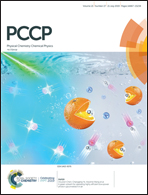The solvent effect on the photodeprotection of anthraquinone protected carboxylic acid unravelled by time-resolved spectroscopic studies†
Abstract
Time-resolved spectroscopy studies coupled with the results from density functional theory (DFT) computations were utilized to unravel the photodeprotection reaction mechanism(s) of AQ protected p-methoxybenzoic acid (1) and its influence on the solvent was examined. It has been found that in aprotic organic solvents such as acetonitrile only the triplet state species was seen, whereas a hydrogen atom transfer (HAT) reaction takes place in isopropanol (IPA) to yield the aromatic ketyl radical species for 1. Compound 1 undergoes HAT and a proton transfer process sequentially to accomplish the release of the leaving group in protic organic solvent MeOH and MeOH–H2O solutions and photodeprotection is more favourable in the latter solution due to the stronger proton mediation ability of the water molecules and this system also facilitates the potential application of 1 in biological systems. Although the released acid from photodeprotection reaction can also be seen in another aqueous solvent system of THF–H2O, the by-product of the AQ chromophore undergoes side recombination reaction, which means this the solvent is not preferred for the photodeprotection process. This mechanistic work will help in the future design and development of AQ-PPGs for particular applications.



 Please wait while we load your content...
Please wait while we load your content...